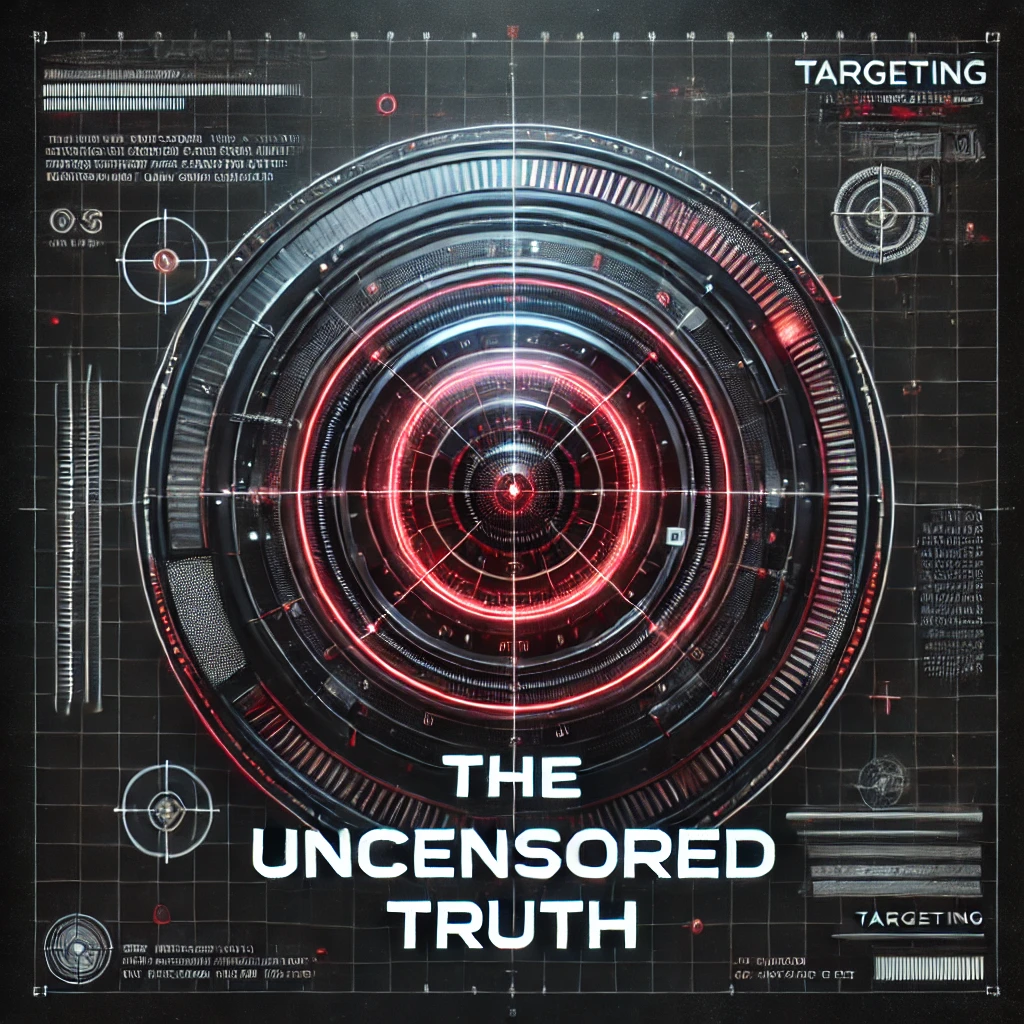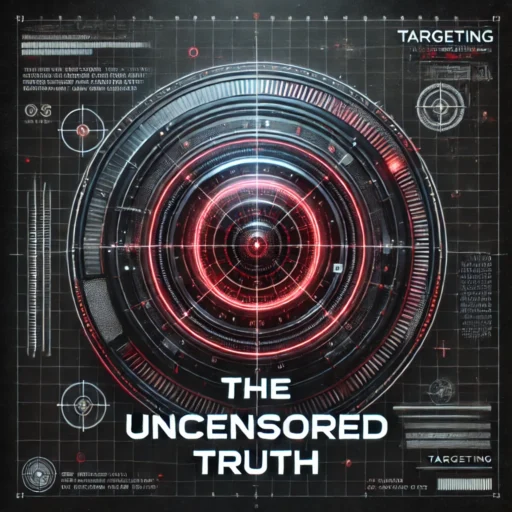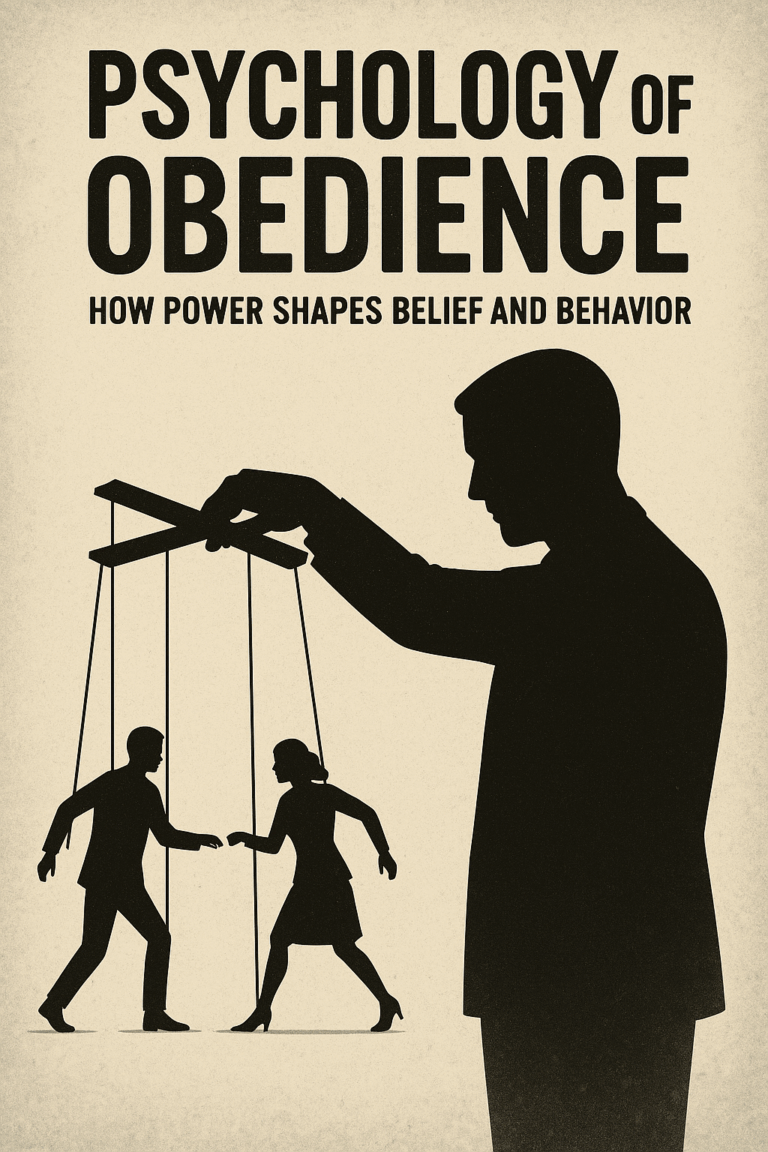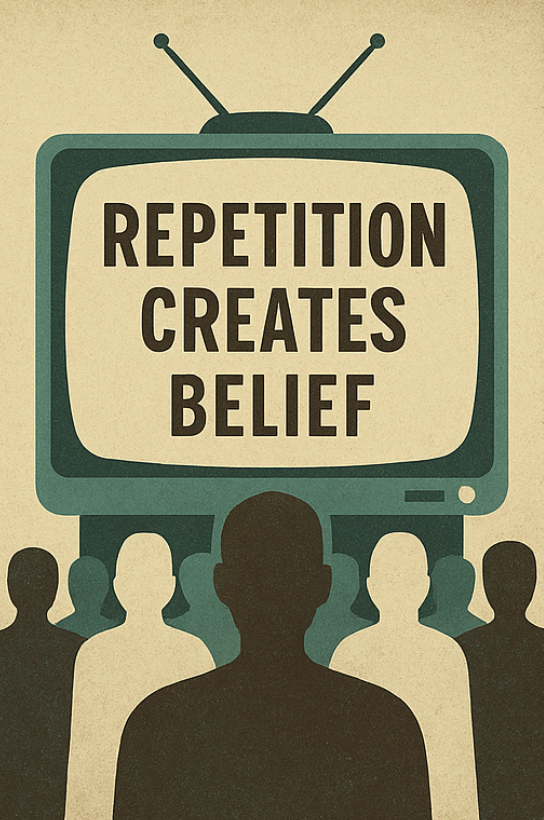Introduction: Obedience, Authority, and Mass Compliance
Why do people obey even when it conflicts with their personal morals or interests? This question lies at the heart of the psychology of obedience. Obedience is a form of social influence where an individual acts in response to a direct order from an authority figure, often doing something they might not do otherwise
Society requires a certain level of obedience to function – we follow laws, heed doctors’ advice, and listen to teachers. This “obedience reflex” can be beneficial, creating order and coordination. However, it can also enable mass compliance with harmful or unjust directives, especially under powerful institutional authorities. Understanding the psychology of obedience is crucial to grasp how authoritarian regimes compel ordinary people, why unethical orders are sometimes carried out without question, and how social control mechanisms leverage our tendency to obey.
This investigative article explores classic studies that revealed our propensity to obey authority, as well as their limitations and controversies. We will examine how renowned experiments – from Stanley Milgram’s shock experiments to the Stanford Prison Experiment – have shaped our understanding of obedience, and how their findings relate to real-world authority and social control. We critically assess each study’s reliability and relevance: some, like Milgram’s and Hofling’s, provide robust insights into the psychology of obedience, while others, like Zimbardo’s prison study, have come under scrutiny. Finally, we discuss how these insights into obedience inform institutional power dynamics, conformity, and the future of governance and personal autonomy.
Understanding the “Obedience Reflex”
Obedience involves a hierarchy of power – an authority figure issues an order, and a subordinate is expected to comply. Unlike simple compliance or peer conformity, obedience carries an implicit threat of punishment or negative consequence for disobedience
From childhood, we are conditioned to trust and obey parents, teachers, and leaders, which ingrains an automatic deference to authority. Psychologists often refer to an “agentic state” to explain the obedience reflex: people see themselves as instruments executing another’s wishes, no longer feeling personally responsible for the actions
In this state, even normally kind individuals might inflict harm if instructed by a legitimate authority because they feel the responsibility lies with the authority, not themselves.
Historically, interest in the psychology of obedience surged after World War II. At the Nuremberg trials, many Nazi officials defended their horrific actions by claiming they were “just following orders.” This raised a disturbing question: Could ordinary people commit atrocities under orders from authority? In the early 1960s, Yale psychologist Stanley Milgram set out to test this, wondering if “Eichmann and his million accomplices in the Holocaust were just following orders” or if something unique made them accomplices
Around the same time, other researchers examined how situational pressures and roles could drive cruel behavior. These inquiries gave birth to several now-famous – and sometimes infamous – experiments probing the psychology of obedience and mass compliance.
Below, we delve into these classic studies. Each reveals different aspects of the obedience reflex: how authority can compel compliance, how situational roles can elicit extreme behavior, and how even symbolic cues like uniforms or job titles can increase obedience. We will also discuss the critical responses to these experiments, including ethical controversies and replication attempts, to get a balanced view of what they really tell us about obedience.
Classic Studies in the Psychology of Obedience
Milgram’s Obedience Study (1963) – Insights into the Psychology of Obedience
No study is more synonymous with the psychology of obedience than Stanley Milgram’s electric shock experiments. Conducted at Yale University in 1961–63, Milgram’s experiment recruited ordinary people for what they were told was a memory study. Participants were assigned the role of “teacher” and instructed by an authoritative experimenter in a white lab coat to administer electric shocks to a “learner” whenever the learner answered questions incorrectly. Unbeknownst to the teacher, the learner was an actor who only pretended to be shocked. With each wrong answer, the shock level on the generator was to increase, eventually reaching potentially lethal levels marked “XXX” on the machine.
The results were both startling and sobering: under the experimenter’s insistent prodding (“The experiment requires that you continue,” “You have no other choice; you must go on”), every participant continued administering shocks up to 300 volts, and 65% of participants went all the way to the maximum 450 volts
even as the learner screamed in pain or fell ominously silent. These findings provided the first quantitative evidence of how far average individuals will go in obeying authority figures. Milgram had expected only a tiny fraction of people to inflict the highest shocks, yet a majority did – a result that shocked the scientific community and the public. It suggested that everyday people could perform grievous acts if ordered to do so by an authority, supporting the idea that situational pressures, more than personal traits, were key to mass compliance.
Milgram’s study offered powerful insights. Many subjects showed signs of extreme tension (sweating, trembling, even nervous laughter), indicating an internal moral conflict, yet they continued obeying the researcher’s commands. Milgram concluded that under the right conditions, the obedience reflex is so strong that it can override individuals’ own conscience. He theorized that people enter an agentic state in which they view themselves as executing the authority’s wishes, disclaiming personal responsibility for their actions
In post-experiment surveys, most participants said they were “glad” to have participated, suggesting that the experience was eye-opening for them about their own capacity to obey
Milgram’s 1974 book, Obedience to Authority, further argued that his findings illustrated a universal propensity for obedience that could explain events like the Holocaust.
Critically, Milgram’s work was not without controversy. Ethically, the experiment was troubling: participants believed they were harming someone, and many were visibly distressed. Psychologist Diana Baumrind famously criticized Milgram in 1964 for exposing people to such stress without clear informed consent, saying the emotional conflict might have caused lasting harm.
Milgram defended his ethics by debriefing participants and reporting that a large majority were glad to have contributed, but his study (along with others of that era) helped spur stricter ethical standards for research. Beyond ethics, there were questions of validity: Were participants truly convinced by the setup? In later analyses, historian Gina Perry found evidence that some participants suspected the “shocks” were fake or felt coerced by the experimenter’s prods beyond what the script outlined.
This suggests some of the obedience might have been less “blind” and more forced or feigned, calling into question whether 65% is an overestimate of genuine obedient belief. Milgram’s comparison of his lab results to Nazi perpetrators was also debated – critics noted differences (his subjects didn’t actually harm anyone or have ideological hatred, unlike real-world perpetrators)
In short, while Milgram’s core finding – a majority obey authority even against their conscience – has held up, scholars continue to analyze nuances: the role of belief (did they trust the experiment was safe?), prods that imply no escape, and participants’ identification with the scientific goal rather than pure obedience (a recent interpretation called “engaged followership”).
Notwithstanding these debates, Milgram’s findings have proven remarkably robust. The experiment has been replicated (in modified, more ethical forms) multiple times. Notably, in 2009 psychologist Jerry Burger conducted a partial replication up to the 150-volt point (where the learner first screams to be released) and found obedience rates almost identical to Milgram’s original results
About 70% of Burger’s participants were willing to press beyond 150 volts – a strong predictor of continuing to the end if it had been allowed. Even with participants explicitly told they could withdraw at any time and with milder prodding, obedience remained high.
Other modern iterations, including a French documentary that turned the scenario into a reality-TV game show, similarly found that the majority of people will obey commands to inflict pain when urged on by an authority and the trappings of a legitimate setting. These replications strengthen the reliability of Milgram’s basic insight into the psychology of obedience: under the right conditions, ordinary people can be led to perform extraordinary acts of compliance, for better or worse.
Read more about it here
The Stanford Prison Experiment – A Flawed Case in the Psychology of Obedience
If Milgram’s work is the most famous on obedience, the Stanford Prison Experiment (SPE) is perhaps the most dramatic. Conducted in 1971 by psychologist Philip Zimbardo, the SPE placed 24 college-age men into a simulated prison environment in Stanford’s psychology building basement. Participants were randomly assigned to be either “guards” or “prisoners.” The guards were given uniforms, mirrored sunglasses (to prevent eye contact and humanization), and instructions to maintain order, while prisoners were stripped of personal identity (referred to by numbers, made to wear smocks and even dress-like outfits). Zimbardo himself acted as the prison “superintendent.” The study was intended to last two weeks. The question was simple: would people conform to abusive guard roles and submissive prisoner roles simply because the situation demanded it?
The outcome seemed to provide a chilling answer. According to Zimbardo’s initial reports, within days the guards became sadistic and the prisoners showed severe stress and hopeless obedience. Guards enforced arbitrary punishments and humiliation – making prisoners do push-ups, cleaning toilets with bare hands, or enduring solitary confinement in a dark closet. Prisoners began to break down emotionally. On only the second day, a rebellion by prisoners was quashed by the guards, who grew increasingly cruel. Several participants playing prisoners had emotional breakdowns (one famously screamed “I’m burning up inside!” in panic). Alarmingly, no guard intervened to stop the abuse. The experiment spiraled so out of control that it was terminated after just six days (on the urging of a visiting researcher horrified at the conditions). Zimbardo concluded that certain situations can cause good people to behave in evil ways they never predicted
In other words, the Stanford Prison Experiment seemed to demonstrate an “obedience reflex” to institutional roles: people readily conform to authoritative expectations (guards becoming tyrants, prisoners becoming passive and obedient) without explicit orders at all.
However, decades of scrutiny have revealed major flaws in the Stanford Prison Experiment, turning it into a cautionary tale of how not to conduct – or interpret – an obedience study. Methodologically, it’s now acknowledged that the SPE was more of an improvised role-play than a scientific experiment. There was no control group or systematic measurement, and Zimbardo, as superintendent, was not a neutral observer
In fact, he was effectively an authority figure within the experiment, influencing the guards’ behavior. It has since emerged that Zimbardo instructed the guards to act tough, and at least one “guard” later said he consciously role-played an abusive persona because he thought that’s what the researchers wanted. This indicates demand characteristics – participants guessed the study’s purpose and behaved accordingly – rather than spontaneously “becoming” brutal guards. Similarly, the most dramatic prisoner breakdown, once touted as evidence of the situation’s power, was later revealed to have been largely faked by the prisoner acting the part
These revelations, from interviews and archival recordings, undermine the SPE’s credibility as evidence of the natural emergence of tyranny. In essence, the participants were performing obedience to expected roles more than experiencing a genuine transformation.
Ethically, the experiment was deeply problematic as well. Participants suffered abuse and extreme stress; by modern standards the study would never pass an ethics board. Even at the time, there were concerns – the experiment continued even as young men cried and begged to leave, blurring the line between role-play and reality. While Zimbardo has defended the study’s value as a “dramatic demonstration” of situational power, he himself admitted it “doesn’t fit the standards of what it means to be an experiment”
Many in the scientific community now agree the SPE was more anecdotal and theatrical than scientific. A 2019 analysis in American Psychologist went so far as to debunk the Stanford Prison Experiment’s conclusions, providing evidence that the outcomes were largely orchestrated and predetermined by the researchers
Despite these issues, the Stanford Prison Experiment gained tremendous fame – it appears in countless textbooks and popular accounts as a demonstration of how situations can foster authoritarian behavior. It’s important, though, to critically separate the lesson from the legend. The idea that people can conform to oppressive roles isn’t baseless – real-world atrocities (from prison abuses to genocides) do show people sliding into roles and obeying implied expectations. But the SPE, as originally presented, likely overstated the case. Later attempts to replicate the study tell a more nuanced story. In 2002, British researchers Reicher and Haslam conducted the BBC Prison Study (with TV cameras rolling) in a similarly divided guards-prisoners setup. The outcome was very different: the guards did not unify into a brutal force, and prisoners eventually banded together and rebelled against the authority, leading to the collapse of the guard-prisoner hierarchy. This failure to mimic Zimbardo’s results suggests that group behavior under authority is not as simple as a “Lucifer effect” where anyone in the uniform becomes cruel. Factors like leadership, group identity, and resistance norms can mitigate or prevent tyrannical obedience. In summary, the Stanford Prison Experiment remains a gripping story about obedience and authority, but as science, it is severely flawed.
Its limitations and potential biases (such as coaching the guards) mean we must be careful in drawing conclusions from it. The study’s popularity in public discourse belies the fact that it provides at best a cautionary illustration – and at worst a false narrative – about how obedience and abuse manifest in institutional settings. Modern psychologists largely agree we should “stop celebrating this work” as proof of anything, and instead view it as a historical footnote in the psychology of obedience, notable for sparking discussion and further research, but not as a sound piece of evidence on its own.
Read more about it here
Hofling’s Hospital Experiment – The Psychology of Obedience in Real Life
In 1966, psychiatrist Charles K. Hofling conducted a subtle but illuminating field experiment to test obedience in a real-world professional context
Hofling’s study unfolded in hospital wards, where the subjects were 22 unwitting nurses going about their normal routines. Each nurse received a phone call from an unknown doctor who urgently requested they administer a dose of a drug called “Astroten” to a patient. The catch: the requested dose (20 mg) was double the maximum safe dosage listed on the box, the drug was not on the official roster of approved medications, and hospital policy explicitly forbade taking prescriptions over the phone from unfamiliar doctors. In other words, the nurses were being asked to violate multiple rules and risk patient harm simply because a self-identified doctor (an authority figure in the hospital hierarchy) told them to.
The results were striking. Despite the clear red flags, 21 out of the 22 nurses were prepared to comply with the doctor’s order – going as far as picking up the medication and heading to the patient’s room to administer it – until they were intercepted as part of the experiment
Only one nurse refused outright. This means 95% obedience in a scenario that closely mimicked a real-life medical error situation. It’s especially revealing because when other nurses and nursing students were asked hypothetically what they would do in such a scenario, the vast majority said they would refuse to give the overdose. The huge gap between the nurses’ confident predictions and their actual obedient behavior under pressure highlights how authority can compel compliance even when people know better. It seems that the simple act of being told by a doctor – an authority in the medical hierarchy – triggered an obedience reflex in the nurses, overriding their training and the rules.
Hofling’s experiment is a powerful demonstration of the psychology of obedience because it occurred in a natural setting with real stakes (unlike Milgram’s lab or Zimbardo’s simulation). The nurses weren’t college students or volunteers in an obvious experiment; they were professionals on the job. Their obedience therefore underscores how hierarchical structures (like doctor-nurse relationships) can produce compliance with orders even when those orders endanger a patient and break protocol. The nurses later explained their actions with reasons like “I assumed it must be an emergency” or “The doctor must know what he’s doing,” reflecting a strong deference to authority and an assumption that obeying the doctor was the correct action in context.
While far less famous than other obedience studies, Hofling’s field experiment is academically respected for its ecological validity. It shows that the psychology of obedience isn’t just an artifact of lab theatrics – it very much operates in the real world. That said, the study has its own ethical and practical limitations. Deceiving nurses and potentially causing them distress (one can imagine the horror a nurse might feel upon learning they almost harmed a patient) raises ethical issues, and such a study likely wouldn’t be allowed today. Also, it was conducted in the 1960s; modern nursing practices and empowerment of nurses to question doctors might yield different results. Nonetheless, the core lesson stands: in high-stakes environments with clear power hierarchies, individuals often default to obedience, sometimes at the cost of critical thinking. Hospitals today train staff to practice “safe harbor” – to question or refuse improper orders – precisely because unthinking obedience can be dangerous. Hofling’s study provided early evidence prompting such changes. It remains a sobering real-life example of mass compliance on a small scale (nearly all nurses obeying) and highlights how institutional authority can trump individual judgment if not actively kept in check
Read more about it here
Bickman’s Uniform Study – Authority Symbols and the Psychology of Obedience
Can something as simple as a uniform or title increase obedience? In 1974, psychologist Leonard Bickman conducted a series of field experiments in New York City to find out. His question was straightforward: do people obey a stranger’s commands more readily if that stranger looks like an authority figure? The setup involved research assistants (confederates) dressing in different outfits – one dressed as a security guard (complete with a uniform and badge), another as a milk delivery man, and another in ordinary casual clothing. These confederates would approach unsuspecting pedestrians on the street with minor requests or orders. For example, one scenario was pointing to a bag of trash on the ground and saying, “Pick up this bag for me!” In another, the confederate (standing near a parking meter) would say, “This fellow is over-parked but doesn’t have change. Give him a dime!” The requests were deliberately trivial but somewhat odd, to see if people would comply without any real incentive or authority beyond the appearance of the requester.
Bickman’s findings provided clear evidence that symbols of authority increase compliance. When the confederate wore a security guard’s uniform, people obeyed his orders much more often than when he wore plain clothes or a milkman’s outfit. In fact, the obedience rate was about 80% when he was in a guard uniform, compared to much lower rates in the other conditions. Even without a real badge or formal power, the semblance of authority influenced citizens’ behavior. For instance, many pedestrians stooped to pick up litter or handed over a coin simply because the request came from someone who looked like a guard giving an order. This effect speaks to the legitimacy factor in the psychology of obedience: people are inclined to obey commands when they perceive the source as legitimate authority. A uniform, title, or badge acts as a heuristic cue – a shortcut signal – that the person giving the order has the right to do so, and that we ought to comply.
While Bickman’s study might seem light-hearted compared to the more intense experiments discussed earlier, it offers important insights. It shows that obedience isn’t only about explicit threats or high-stakes situations; it also manifests in everyday social interactions and minor acts of compliance. If a mere costume can compel people to obey arbitrary requests, one can imagine how powerful real authority symbols (police uniforms, doctor’s white coats, military ranks) are in securing compliance. This has practical implications: for example, people might hesitate less to challenge someone in authority attire, even if the person is misusing that authority.
Bickman’s work also highlights how contextual cues and social norms play into obedience. On the street, being approached by someone barking orders is unusual. Participants later reported they complied in part because the requests were phrased like orders (no polite “please,” just a firm command) and they felt momentarily that they had to do it. The uniform-wearer’s brusque tone triggered a compliance script: “He’s acting like a police/security officer, so I guess I must do as told.” Conversely, when the same person asked politely or was dressed ordinarily, people felt more freedom to say no. In effect, the trappings of authority reduced the perceived choice to disobey.
Critically, like all studies, this one had limitations. Some scholars note that the scenario was artificial – in real life, strangers rarely walk up and order you to perform random tasks, so participants were caught off guard and possibly obeyed out of momentary confusion or the oddity of the situation. Personality and context mattered too: not everyone obeyed, and factors like the confederate’s tone of voice or the individual’s mood could sway the outcome. Nevertheless, Bickman’s uniform study robustly supports a key aspect of the psychology of obedience: the power of perceived authority. It quantifies how much more likely people are to follow instructions when they come from someone who looks authoritative. This finding complements Milgram’s and Hofling’s results by showing the gradient of obedience – from extraordinary acts (shocking someone, risking a patient’s life) to simple compliance (picking up litter) – all amplified by authority. It underscores that mass compliance can be engineered or encouraged through superficial means as well (like clothing or titles), not only through explicit coercion.
Read more about it here
Obedience and Authority in the Real World: From Conformity to Social Control
The laboratory and field studies above, despite their varying credibility, collectively paint a picture of how obedience functions in human psychology. But how do these findings translate to real-world dynamics? Outside the lab, obedience is a double-edged sword: it is essential for organized society yet can be exploited to undermine individual autonomy and facilitate oppression. The psychology of obedience intersects with concepts of institutional authority, conformity, and social control in many real scenarios:
- Institutions and Authority Hierarchies: In military organizations, obedience to orders is a core value – soldiers are trained to respond reflexively to commands. This discipline can be life-saving in battle when split-second reactions are needed. However, it also means atrocities can occur if unlawful orders are given; the My Lai massacre during the Vietnam War, for example, involved soldiers obeying a commander’s directive to kill unarmed villagers. Courts and ethics inquiries often grapple with the extent to which “just following orders” can excuse individuals. Findings like Milgram’s (65% willing to administer lethal shocks under an authority’s instruction) show that many people will obey orders even when they cause harm, which provides a psychological basis for why such war crimes and police brutality incidents happen. It’s not that all perpetrators are monsters; often, they are ordinary people in an environment that powerfully pressures them to conform and obey. Recognizing this has led militaries and police forces to emphasize ethical training and the duty to refuse illegal orders, to counteract the blind obedience tendency.
- Conformity versus Obedience: Obedience to authority is related to but distinct from peer conformity. Psychologist Solomon Asch’s classic experiments in the 1950s (where participants conformed to a group’s obviously wrong judgment about line lengths) demonstrated the power of social conformity – aligning with one’s peers. Both obedience and conformity result in compliance, but the driver differs: one is authority, the other is majority opinion. In real life these often work together. For instance, within a corporate culture, an employee might obey a boss’s directive (authority) and also go along because all their colleagues do (conformity). The psychology of obedience helps explain not just obedience to a single authority, but mass compliance when authority and conformity pressures combine. A poignant example is the cultural obedience in authoritarian states, where propaganda (shaping norms) and policing (enforcing orders) together produce high public compliance. Citizens not only fear punishment (authority) but also see everyone else complying (conformity), which reinforces the behavior. Research shows that the presence of even one dissenter or ally can dramatically reduce obedience and conformity. In Milgram’s variations, when participants witnessed peers refuse the authority’s orders, their own obedience rates plummeted (in one variant, down to 10% fully obedient). This indicates that social support empowers resistance to authority. Conversely, in hierarchical or group settings where no one else questions the leader, individuals are far more likely to go along, even if uneasy.
- Legitimacy and Social Contract: People are more likely to obey when authority is perceived as legitimate and just. Sociologist Max Weber noted that authority can be charismatic, traditional, or legal-rational – the last being the kind underpinning modern institutions. When authorities are seen as rightful (e.g. an elected government, a certified doctor), obedience is mostly voluntary. However, legitimacy can be manufactured or abused. Totalitarian regimes often cloak themselves in pseudolegality or grand narratives to appear legitimate, securing mass obedience beyond what force alone could achieve. In democratic societies, obedience is tempered by the idea of a social contract – authorities have power in exchange for protecting the people’s rights. If authorities violate that contract (through corruption or tyranny), public obedience can erode, replaced by protest or civil disobedience. Psychology of obedience research suggests that people do have breaking points: if orders are too blatantly immoral or authority loses credibility, individuals may defy commands despite personal risk. For example, not all of Milgram’s subjects obeyed to the end – a substantial minority refused at some point, demonstrating personal agency overcoming authority pressure. Understanding what factors increase versus inhibit obedience (e.g. distance from consequences, gradual escalation, presence of dissent, personal responsibility) can help societies encourage rightful compliance (like evacuating during an emergency) while guarding against dangerous obedience (like following unlawful orders).
- Social Control Mechanisms: Authorities often enforce compliance through a mix of surveillance, norms, and sanctions. Consider a panopticon-like situation: if people believe they are being watched (by bosses, cameras, etc.), they are more likely to obey rules even when they personally disagree, a concept consistent with obedience conditioning. Moreover, when obedience is culturally valued (the “good citizen” or “good child” who doesn’t question authority), individuals internalize obedience as a virtue. This was evident in Hofling’s nurses – they likely saw themselves as being good, dutiful nurses by promptly carrying out the doctor’s orders, even though in that case obedience was the wrong choice. Education and upbringing play a role: those raised in very strict, authoritarian households may develop a stronger obedience reflex (as theorized in Adorno’s earlier concept of the “authoritarian personality”), whereas those encouraged to question and think independently might be more resistant. Governments and institutions that desire mass compliance often shape education, media, and rhetoric to favor obedience and discourage dissent. This can slide into indoctrination, where people obey not out of fear but because they no longer recognize wrongdoing – they come to believe that obedience is always right. A historical example is how state propaganda in Nazi Germany cultivated a populace that obeyed discriminatory laws and even participated in persecution, believing they were doing their duty.
On the flip side, modern psychology and sociology emphasize the need for critical obedience – a conscious form of compliance where individuals choose to follow legitimate instructions but remain vigilant. This concept is applied in settings like aviation or medicine, where strict protocols exist, but team members are also trained to perform “critical communicative disobedience” if they believe a superior is making a mistake (e.g. a co-pilot questioning a pilot’s risky decision). The goal is to balance the efficiency of obedience with the safety of independent judgment. This balance is vital in preventing disasters caused by cascading obedience (such as the tragic outcomes when subordinates notice something is wrong but fail to speak up or intervene due to deference).
In everyday life, mass compliance is often tested during crises. Take public health mandates during a pandemic: authorities might require people to wear masks, social distance, or get vaccinated. Compliance (or obedience) in such cases hinges on public trust and perceived legitimacy of the authorities and experts. If people trust the institutions and see the measures as for the common good, the psychology of obedience works hand in hand with personal conviction, leading to broad voluntary compliance. If trust is lacking, obedience falters; people may rebel or simply ignore guidelines, especially if they see peers doing the same (conformity effect). Thus, the psychology of obedience tells us that leadership and legitimacy are key to harnessing obedience for positive ends. It also warns that when leaders misuse their authority or lose moral credibility, the compliance that holds society together can break down, or worse, be directed toward destructive aims.
Reflections: The Future of the Psychology of Obedience
As we look to the future, the psychology of obedience remains profoundly relevant. Our world is shaped by large institutions and authorities – governments, corporations, technologies – that may demand our compliance in new and complex ways. Understanding how and why people obey is critical for navigating the delicate balance between social order and personal autonomy.
Governance and Authority: Insights into obedience will likely shape how governance systems are designed. Democratic societies might take heed of research by promoting transparency and accountability to ensure that obedience from citizens is grounded in trust rather than fear. Leaders who understand obedience psychology can hopefully avoid the abuses of power that history has shown to occur when followers obey without question. On the other hand, authoritarian-leaning regimes could exploit these principles to tighten control – for instance, through sophisticated propaganda that reinforces the legitimacy of the ruler, or through high-tech surveillance that creates a constant sense of being observed (a modern “big brother” inducing compliance). The future may see new forms of authority in artificial intelligence and algorithms – consider how easily people follow GPS navigation or automated instructions. As AI systems become more integrated into decision-making (from credit approvals to law enforcement), will we develop an “obedience reflex” toward machines and systems? Ensuring there are mechanisms to question and override automated authority will be important, so that mass compliance with technology does not override human ethics and judgment.
Public Discourse and Dissent: The psychology of obedience also teaches us about the importance of dissenting voices. A healthy society benefits from individuals willing to question authority when necessary. Research shows that it often takes only a small minority to speak up to break the spell of obedience and encourage others to think critically (as seen when one person refusing in Asch or Milgram’s studies emboldened others). In the future, fostering a culture that values thoughtful questioning – in classrooms, workplaces, and communities – can act as a safeguard against harmful mass obedience. Public discourse that is open and critical prevents the stagnation of “everyone just following orders” or prevailing opinions. Thus, one positive outcome of disseminating knowledge about the psychology of obedience is empowering people with the awareness that just because an authority said it, doesn’t make it right. The more people understand experiments like Milgram’s, the more they may recognize those pressure moments in real life (“I felt I had no choice, but actually I do have a choice”). This awareness can shape personal autonomy in critical ways.
Personal Autonomy and Ethics: On an individual level, reflecting on the obedience reflex forces each of us to consider our own limits and values. In the future, as citizens or employees, we might face situations that test our willingness to comply. Knowing about the psychology of obedience – that feeling pressured or “it was ordered” is a common experience – can help us pause and inject conscious thought into an otherwise automatic response. Psychologists sometimes train people in assertiveness and ethical decision-making to resist unjust authority. For example, medical staff are trained through simulations to question improper orders, and soldiers are educated about the moral and legal duty to refuse illegal commands. Such training could expand in various domains, effectively “inoculating” people against blind obedience. Paradoxically, understanding obedience can make us more autonomous by making us aware of the subtle forces that sway us.
Looking ahead, the role of obedience in society will continue to evolve. Some fear that rising polarization and misinformation erode traditional authorities, leading not to liberation but to people choosing new “authorities” (like demagogues or conspiracy theories) to obey. The obedience reflex doesn’t disappear; it may simply shift to different figures or ideologies. This makes it all the more crucial to ensure that the authorities who command mass compliance – whether they be scientists, politicians, or community leaders – are worthy of obedience and subject to check and balance. As Zimbardo’s and Milgram’s work reminded us, context is powerful. Change the context, and you can change whether obedience yields good or evil.
In conclusion, the psychology of obedience teaches a timeless yet timely lesson: we humans have a strong inclination to follow orders, especially from those we deem legitimate leaders. This inclination can lead to productive cooperation or harmful compliance depending on how it is guided. By critically examining landmark studies – celebrating their insights but also learning from their mistakes – we equip ourselves with knowledge about when to obey, when to question, and how to foster a society where obedience to authority is balanced by moral reflection and the courage to say “no” when it counts. The future will undoubtedly present new tests of our obedience reflex. Whether mass compliance works for the greater good or against it will hinge on how well we apply the lessons, ethics, and self-awareness gleaned from decades of studying the psychology of obedience.
Part 2 – The Manufactured Mind: How Repetition Creates Belief








